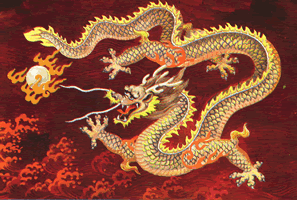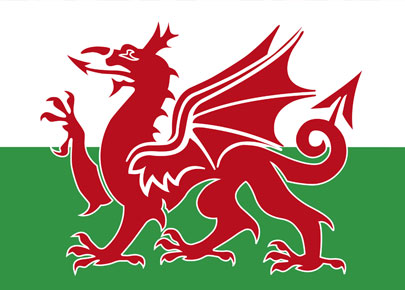
Quotations
Dragon Lore, Myths, Theories
"The Naga (Sanskrit) are a group of
serpent-like creatures described in pre-Buddhist and early Indian Buddhist texts
as “water spirits with human shapes wearing a crown of serpents on their
heads.” Their mortal enemy is the bird-man
Karura and the
Phoenix. As protectors of Buddhism, the Naga are attendants to
Kōmokuten. In China and Japan, the
Dragon
incorporates Naga iconography & supplants the Naga. Says M.W. De Visser in
Dragon in China and Japan, “According to Northern Buddhism, Nagarjuna
(approx. 150 AD), the founder of the
Mahayana
doctrine, was instructed by Nagas in the sea, who showed him unknown
books and gave him his most important work, the Prajna Paramita, with
which he returned to India. For this reason, his name, originally Arjuna,
was changed to Nagarjuna, and he is represented in art with seven Nagas over his
head. The
Mahayana school knows a long list of Naga Kings, among whom the eight
so-called Great Naga Kings are the following: Nanda (called Nagaraja, King
of the Naga), Upananda, Sagara, Vasuki, Takshaka, Balavan, Anavatapta, and
Utpala. These eight are often mentioned in Chinese and Japanese legends as
the Eight
Dragon
Kings (八龍王 Hachi Ryū-ō), and were said to have been among Buddha’s audience,
with their retinues, while he delivered the instructions contained in the Sutra
of the Lotus of the Good Law.”
-
The Naga
"The most powerful generalized type of Chinese dragon is the horned dragon,
or lung, which can produce rain and is totally deaf. Additionally, there is a
homeless dragon (Ii) that lives in the ocean and another type (chiao) that is
scale-covered and usually inhabits marshes but also keeps dens in the mountains.
There are also nine ways the Chinese have traditionally represented these
dragons, each one revealing a different dragon characteristic. There are dragons
carved on the tops of bells and gongs, because of the beast's habit of calling
loudly when attacked. A second type is carved on the screws of fiddles,
since most dragons are fond of music. A third is carved on the tops of
stone tablets, because of dragons' love of literature. A fourth is found
at the bottom of stone monuments, as dragons can support heavy weights. A
fifth is placed on the eaves of temples, as dragons are ever alert to danger.
A sixth occurs on the beams of bridges, since dragons are fond of water. A
seventh is carved on Buddha's throne, as dragons like to rest. An eighth
is placed on the hilts of swords, since dragons are known to be capable of
slaughter. The ninth is carved on prison gates, as these are dragons that
are fond of quarreling and trouble making. The colors of Chinese dragons
are evidently quite variable, but in the case of the chiao type its back
is striped with green, its sides are yellow, and it is crimson underneath. The
nine major characteristics of a lung type dragon include a head like a
camel's, horns like a deer's, eyes like a hare's, ears like a bull's, a neck
like an iguana's, a belly like a frog's, scales like a carp's, paws like a
tiger's, and claws like an eagle's. It has a pair of large canine teeth in its
upper jaw. The long, tendril-like whiskers extending from either side of its
mouth are probably used for feeling its way along the bottom of muddy ponds. In
color dragons varies from greenish to golden, with a series of alternating short
and long spines extending down the back and along the tail, where they become
longer. One specimen had wings at its side, and walked on top of the water.
Another tossed its mane back and forth making noises that sounded like a flute."
- Chinese
Dragons
"Those who follow the clockwise path are governed by the changes of Yin and
Yang. Those that take the reverse path, however, will be able to walk in
the void."
- Tao-hsuan p'ien
"Four Guardians of the Four Compass Directions, Celestial Emblems of the Chinese Emperor, Sì Shòu
四獸.
Tortoise (Black Warrior) = North, Winter, Black. Water
White Tiger (Kirin) = West, Fall, White, Metal.
Red Bird (Phoenix) = South, Summer, Red, Fire.
Dragon = East, Spring, Blue/Green, Wood."
-
Four Guardians of the Four Compass Directions
"Standing at the Mysterious
Centered in the Eternal Now,
Balanced in Body and Open in Mind,
Rooted into the Sacred Space,
Motionless as the Golden Mountain,
Fingers around the Primeval Sphere.
Dragons and Tigers are still dreaming -
Ready for Rebirth.
I breathe in, the World Breathes Out.
The Gate of Space opens;
Heaven moves and Yang is born.
The hands move out, embracing the One.
The mind settles and is clear.
The Dragon Howls,
Ravens fill the Vast Cauldron,
Mind forms melt like mercury,
Spirit rises in the Clouds of Eternity.
Yin appears like the moon at dusk.
I breathe out, the World Breathes In.
The Doors of Emptiness close;
Earth quiets and Yin is born.
The hands move in, entering the One.
The body settles and becomes whole.
The Tiger Roars,
The Great Ox is nourished by the Valley Spirit,
Substances spark from flaming furnaces,
Essence roots in the Watery Flesh.
Yang appears like the sun at dawn.
Dragons and Tigers
Transformed within the Mysterious Pass -
Chanting and Purring.
Awakened,
Peaceful,
Free."
- Michael P. Garofalo,
Opening
at the Mysterious Pass, 2003
Opening Hands and Closing Hands in
Sun Taijiquan
"According to this primitive evolutionary theory,
the dragon is thus the original ancestor of all birds, mammals, fish, and
crustaceans. In fact, sometime before the year 140 B.C., a theory had already
appeared in China that held the dragon as the spiritual ancestor of all living
things, according to the following genealogy: 1. The yu chia gave rise to the
flying dragon; the flying dragon gave rise to the phoenix; the phoenix gave rise
to the luan (another mythical bird); the luan gave rise to the common bird, and
all animals with feathers are its descendants. The fei dragon is the
ancestor of all birds. 2. The mao du gave rise to the ying dragon;
the ying dragon gave rise to the chien horse; the chien horse gave rise to the
chilin; the chilin gave rise to the common mammal, and all mammals are its
descendants. The ying dragon is the ancestor of all mammals. 3.
The chieh lin gave rise to the chiao dragon; the chiao dragon gave rise to the
kun keng (a legendary fish thousands of miles long); the kun keng gave rise to
the chien hsieh; the chien hsieh gave rise to the common fish, and all animals
with scales are its descendants. The chiao dragon is the ancestor of all
fish. 4. The chieh tse gave rise to the hsien dragon; the hsien
dragon gave rise to the hsuan tortoise; the hsuan tortoise gave rise to the ling
tortoise; the ling tortoise gave rise to the common tortoise, and all
crustaceans are its descendants. The hsien dragon is the ancestor of all
crustaceans. One can thus see that the dragon appears in many forms and
embodies the divine creative force of the universe. More contemporary depictions
of the dragon, however, follow Wang Fu's prescription stating that the dragon
has "three sections and presents nine likenesses," making the dragon an
amalgamation of characteristics from all kinds of animals and the spiritual
ancestor of all living things. Even human beings are considered the descendants
of the dragon."
-
Dragon
Lore
"Love is the power to feel through the feet in Earth and through the spine into
heaven to mingle into motion the inner wheels, to awaken the sleeping Serpent.
- Dei Hughes, "Sacred Loyalties"
"As the glory of May-time unfurls in every leaf and flower, we begin to feel a
new well-being in our bodies, a sense of vigor and energy that we have lacked
over the cold months of winter. In terms of Celtic understanding, we are
experiencing the nwyfre (NWIVE'ry) of the earth in our own bodies.
Nwyfre is a Welsh word that means the subtle energy field of the earth;
it is often used poetically for the sky or heavens.
Every sentient being has its own energy field or nwyfre
as well. The symbolic representation of nwyfre is the dragon, which
is a very important emblem in Britain (the red dragon being the guardian beast
of Wales and appearing upon its flag). The awakening of the dragons of the
land traditionally happens about the time of Beltane. The nwyfre of
the land rise up at summer's approach, and the dormant dragons, emblems of the
land's power, rise from their dark earth caverns upon powerful wings.
To experience the awakening of the dragons of nwyfre
in our bodies, we need to take ourselves out into the open air, to stand without
concrete between our bare feet and earth, to experience the daily miracle of
life within our bodies. If we make this our practice, our nwyfre
will not be lacking.
Stand on the green earth and close your eyes, soaking up the
light of the sun and the warmth of the earth at the same time. Be aware of
the nwyfre of the earth. Now become aware of your own. As you
breathe in, experience drawing up the subtle energy of the earth. Give
thanks for renewed energy and life."
- Caitlin Matthews, The Celtic Spirit: Daily Meditations for the
Turning Year, 1999, p. 207

Return to the Realms of the Dragons
© Valley Spirit
Qigong, Green Way Research, Red
Bluff, California, 2010-2012
By Michael P. Garofalo, M.S., All Rights Reserved.
This webpage was first posted on the Internet on May 22, 2010 at: http://www.egreenway.com/dragonsrealms/DT6.htm
This webpage was last updated on May 14, 2012
Return to the Realms of the Dragons Webpage